The Murder of Luca Brasi: The Curiously Moving Death of a Henchman
By Jenna Allen
The scene begins with the camera positioned at a low angle, hovering just above ground level. We are transported into a setting never before seen, one that is fashionable, well-decorated, Art Deco-themed, and visually intriguing. It is a mere hallway but spacious, a series of platforms and stairs—pristine, white, heavily mirrored, gold-accented, and possessing an opulence that plainly states “luxury.”
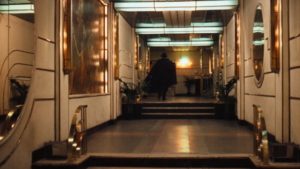
We see the lone figure of Luca, whose back faces the camera, dressed in all black and ascending the stairs. His garments are dark-toned, contrasting with the surge of brightness that is the background. His looming stature fills up almost the entirety of vertical space from ground to ceiling, as he ascends with a casual, confident gait. He is out of place—a dark, lonely figure situated among a landscape of brilliant white. When he reaches the top he removes his coat and, if we were unsure before about the identity of the tall figure, the wide profile allows us to see him clearly now: it’s Luca Brasi, Don Corleone’s most valued henchman.
The surrounding mirrors display his dark demeanor—his sober, calm professionalism—in multiple dimensions, but there seems to be one essential Luca. He is, indeed, a professional. He is a man sent out on a mission—a mission by Don Corleone.
There is something ironic about Luca’s presence here, and it is not simply his appearance. From the previous scene, we already know that Luca is to prepare the bait, to feign discontent with the Corleone family, and to ultimately test the waters for this newly emerging character, Sollozzo. Luca’s loyalty is executed in the form of a betrayal—one that is acted, of course. Thus, when Luca first steps foot into the club, with the intention to carry out the Don’s plan, a silent tension smothers the air. This is all a test.
It is a test for Sollozzo—in the most obvious sense, we want to know if he can be trusted—but more so it is a test for Luca, our principal interest in this scene. We are here directed to see how Luca will fare, this loyal, eagerly-obliging man who has been thrust into the Don’s dirty work. We cannot help having some stored attachment for this man, who first endears himself to us at the wedding with his poorly performed thank you to the Don. Thus, when Luca dies on an errand of loyalty, we register heavy tremors of shock. A sense of loss, keyed to the corruption of Sollozzo and Tattaglia, begins to color The Godfather, often exploding upon us in the most sudden and savage of ways..
Though the impact of Luca’s death scene has much to do with surprise, it also has deeper, more complex roots. Our emotional response to Luca’s death hinges on what we’ve come to know about him: at this point in our experience of the film, he is not just some brawny, dispensable crony, but rather an actualized, round character. In Puzo’s novel, Luca Brasi’s loyalty to Don Corleone is established through a long history of violence—murders committed on Corleone’s behalf. (Annotated Godfather, 75) In the film, Brasi is a much-abbreviated version of this ruthless killer, but he is fleshed out just enough, and with singular idiosyncrasies, to draw our attachment.
* * *
First impression-wise, it is difficult for the viewer to focus on any aspect of Brasi other than his gigantism. He possesses all the properties of a menacing assassin whose sheer bulk and size instantly disclose his raw strength. Kay echoes this notion at the wedding, remarking to Michael in a low tone, “See that scary guy over there?” The actor who fills this “scary guy” role is 6’6” Lenny Montana, an ex-wrestler who had been known by the moniker “The Zebra Kid” and was the World Champion at one point. (Annotated Godfather, 37) Such a figure inadvertently dwarfs all the wedding guests around him.
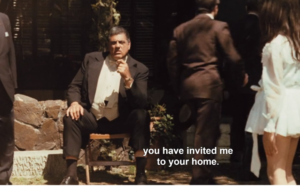
But the longer the camera focuses upon Brasi, the more we see of his contrasting, almost endearing interiority. The “big scary man” who is talking to himself is actually frozen in deep concentration, fumbling and repeating the same words over and over again. He strains himself in the midst of merriment. Everyone around him is alight with joy and then there is Brasi, mumbling to himself, a heap of nerves. There is something sweet about a man who does not match the fear he inspires—who is quickly deemed the ‘scary’ guy while possessing a slightly softer, grateful side within.
The death of Brasi is much more than transactional—not “strictly business,” to use a phrase from the film. It is emotionally affecting.
By suppressing Puzo’s version of Brasi, who is marred by a more unforgivable past, Coppola gives us a Brasi who is known only by his loyalty. This Brasi exhausts himself with perfecting a memorized speech of gratitude, and even gives money afterward for the bridal purse of the Don’s daughter. Yes, he kills for Don Corleone, but he also receives an invitation to an exclusive family wedding; we come to know him purely through this bond to Don Corleone. His death, then, is much more than transactional – not “strictly business,” to use a phrase from the film. It is emotionally affecting —the poignant consequence of his “pledge [of] never ending loyalty.”
***
At the start of the scene that leads to his death, we already know what Luca Brasi really is. He is a fabricated defector who must, for now, bury his unshakable allegiance to Corleone. When he steps into this lavish place of meeting, we as viewers are thrust into a moment of waiting, a moment of pressing uncertainty. The gold ornamentation, the trendy aesthetics, the overall unspoiled feel—burgundy walls, golden dim lights, everything shrouded in shadow: all these elements foster a mellow ambiance. Surely, no violence can erupt in a place as sedate and sophisticated as this? And even if it does, we have faith in the reliable, tried-and-true Brasi.
When we meet the figures of Bruno Tattaglia and Virgil Sollozzo inside, there is something about them that blends into this cool, fashionable setting. This is the Italian-American Mafia—sleek entrepreneurs, cleverly veiled criminals—and this is where they meet, as businesspeople accustomed to a tableau of luxury. Tattaglia immediately sets the tone, introducing himself as if he were all smiles and good cheer: “Luca! I’m Bruno Tattaglia.” He effortlessly assumes a businessman’s air of affability, embodying a type of bold cordiality that is difficult to second-guess.
“I know.” Brasi’s curtness marks a break with the manufactured pleasantries. Brasi, in fact, seems incongruously situated here from the start. The inaptness of the meeting is magnified by his unrelenting stoniness.
Meanwhile the camera angle captures the scene from the characters’ torsos up, panning back and forth frequently, with equal attention capturing each expression. Tattaglia maintains an easy casual aura, standing directly under a cascade of light, smiling as he speaks, professional and almost jovial. When Sollozzo enters, taking his place beside Bruno, he mimics this air of friendliness.
The opposing sides are clear contrasts in this way. Sollozzo, chatty and encouraging, leads the conversation with a piercing, alert gaze. He dresses warmly, in welcoming beige and camel-colored tones—all in all, appearing as a lighter flash of color against Luca, who is on the opposite side, darkly attired, stoic and shadowed, with a reserved nature that seems unwittingly out of place.
As with many scenes in The Godfather, we could not possibly have guessed the coming action. In a brief, preceding scene, Brasi, in preparation, dons a bullet-proof vest while he loads his gun. “The audience is probably waiting for the vest to come into play,” Coppola writes in his notebook. “This is a beautiful piece of misdirection.” (Annotated Godfather, 75)
The business pauses for a moment, as Brasi, thinking the ‘deal’ over, takes out a cigarette. Then the quiet, steady hum of this scene is shattered in an instant. With swift movements and efficient teamwork, the violence occurs almost too quickly to even process. Tattaglia drops his amiable facade, and the camera zooms in as he grabs firmly onto Brasi’s arm. Next, a knife plunges into the frame and lands with a tell-tale thud into Brasi’s restrained hand.
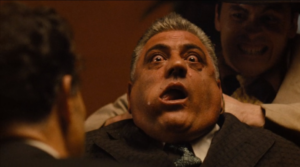 We hear a simultaneous scream, made more unsettling by its deepness, and by our awareness that it comes from a grown man who cannot suppress the anguish of his pain. And just like that, without warning, we are ejected at once from the scene’s mellow, easygoing tempo to one of fast-paced horror. By the time the garrote is placed around Brasi’s throat by an unknown assailant, we want Luca to overpower him, to use brute strength or even his gun to turn the outcome around. Ultimately, we just want his suffering to stop.
We hear a simultaneous scream, made more unsettling by its deepness, and by our awareness that it comes from a grown man who cannot suppress the anguish of his pain. And just like that, without warning, we are ejected at once from the scene’s mellow, easygoing tempo to one of fast-paced horror. By the time the garrote is placed around Brasi’s throat by an unknown assailant, we want Luca to overpower him, to use brute strength or even his gun to turn the outcome around. Ultimately, we just want his suffering to stop.
But there is no easy escape. Instead of ceasing, Brasi’s strangulation is extended as long as possible. In this striking, visually repulsive moment, we are forced to endure his death in its entirety. Luca’s gasps become softer. His face becomes tinged with a purple, bruised color. His eyes are pushed out of their sockets and become two vacant bulges as his tongue sticks unnaturally outside his mouth. In preproduction, Coppola’s special effects memo reads, “This is probably the most difficult effect in the movie.” Luca’s dying moments here are backed by sufficient research to capture all the unpleasant physiological changes that occur realistically with strangulation. (Annotated Godfather, 76) This scene holds nothing back. Once the choking Brasi ripens to the complexion of a grape, and his limp figure starts to slip under the table, we have to accept the imminence of his death.
Yet Luca’s drawn-out suffering and the morbidly jarring violence of this scene are not inserted in the film simply for the sake of violence, simply to titillate or transfix the viewer. Brasi’s suffering is key to the film’s greater significance, as this short scene marks a monumental turning point within it. From his death alone, The Godfather forges its overarching conflict and defines the ensuing direction of the plot. It takes one scene to dramatically color Sollozzo and Tattaglia as merciless villains.
The murder of Luca Brasi colors Sollozzo and Tattaglia as merciless villains, and seeds feelings of shock, disgust, betrayal, and sadness—out of which emerges the heightened question, “What next?”
The scene seeds, within the audience, feelings of shock, disgust, betrayal, and sadness—out of which emerges a heightened wonder of ‘What next?’ Moreover, Luca’s eventual death does not mean an end to the violence; it is, in fact, the jump starter for it. Brasi’s death, then, opens onto many forms of loss—the loss of a trusted friend, the loss of peace among the Five Families, and all the human losses that we anticipate will arrive with the unprecedented storm that is about reach the Corleones.
Jenna Allen (’18) is a Cal undergrad working on her B.A. in English Literature.
Works Cited
Jenny M. Jones, The Annotated Godfather (New York: Black Dog & Leventhal, 2007).

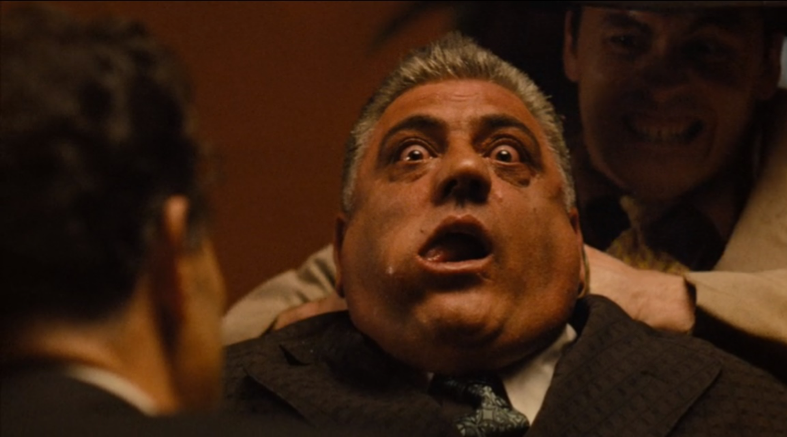
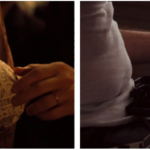
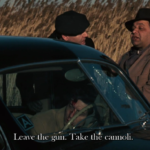
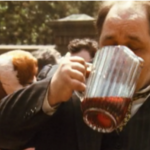

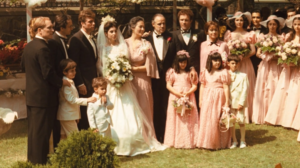 Early in the opening wedding scene of The Godfather, a photographer lines up the Corleone family, preparing a family photo to solemnize the marriage of Constanzia, or Connie, Corleone to Carlo Rizzi. Yet Vito Corleone, the Don of this Sicilian family, notes his youngest son’s absence and so stops the shot from being taken: “We’re not taking the picture without Michael.” A picture is forever, and Vito—the center of the family, and with an especially soft spot for his son Michael—insists that all must be present and all must be willing to play their part. What Vito has created through the Corleone family is represented in its purest and most picturesque form by Connie’s wedding, which is huge, vibrant, and cheerful.
Early in the opening wedding scene of The Godfather, a photographer lines up the Corleone family, preparing a family photo to solemnize the marriage of Constanzia, or Connie, Corleone to Carlo Rizzi. Yet Vito Corleone, the Don of this Sicilian family, notes his youngest son’s absence and so stops the shot from being taken: “We’re not taking the picture without Michael.” A picture is forever, and Vito—the center of the family, and with an especially soft spot for his son Michael—insists that all must be present and all must be willing to play their part. What Vito has created through the Corleone family is represented in its purest and most picturesque form by Connie’s wedding, which is huge, vibrant, and cheerful.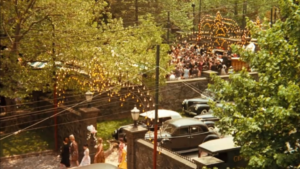 In the first shot following Vito’s dealings with Amerigo Bonasera, we glimpse the throng that has assembled for the event: though a tree covers half of the crowd, there are still dozens of visible people milling around, and by placing the camera far from the event, the individual people become a blur and turn into one huge sea of costumed bodies. The image suggests how, to the Corleones, a family should function: though the individuals that make up the larger family business are essential to its workings, they are all under the guise of one group and so are united by that group. Even with a sizable attendance already inside the estate, people can be seen still walking into the courtyard. Everyone, from tiny toddlers to their aging grandparents, must come and pay respects to Connie in this momentous event.
In the first shot following Vito’s dealings with Amerigo Bonasera, we glimpse the throng that has assembled for the event: though a tree covers half of the crowd, there are still dozens of visible people milling around, and by placing the camera far from the event, the individual people become a blur and turn into one huge sea of costumed bodies. The image suggests how, to the Corleones, a family should function: though the individuals that make up the larger family business are essential to its workings, they are all under the guise of one group and so are united by that group. Even with a sizable attendance already inside the estate, people can be seen still walking into the courtyard. Everyone, from tiny toddlers to their aging grandparents, must come and pay respects to Connie in this momentous event.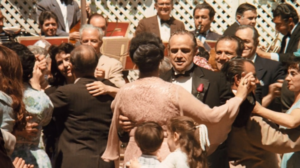 Yet Vito is not just a man who spends a lot of money to make his daughter’s wedding a great celebration; he’s the sort of father who actively shows his care with that money by partaking in the festivities, spending time with his family throughout despite his ongoing business deals behind the scenes. This scene fills the wedding with his attention and care as he dances with his wife in the midst of the crowd. Smiles on their faces, the couple waltz as Vito makes an inaudible comment to his wife that conveys the couple’s agreeable intimacy.
Yet Vito is not just a man who spends a lot of money to make his daughter’s wedding a great celebration; he’s the sort of father who actively shows his care with that money by partaking in the festivities, spending time with his family throughout despite his ongoing business deals behind the scenes. This scene fills the wedding with his attention and care as he dances with his wife in the midst of the crowd. Smiles on their faces, the couple waltz as Vito makes an inaudible comment to his wife that conveys the couple’s agreeable intimacy.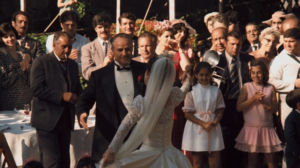 This scene is mirrored again at the end of the wedding: Vito leads his daughter through the crowd of clapping attendees, clutching her hand tightly. Holding hands is a sign of affection often seen between a parent and a young child, and in this context the meaning is still valid—perhaps even more so due to Connie’s older age and the likelihood that they no longer are so physically close. As Vito carefully lays his hand on her waist and they begin to waltz, Connie speaks inaudibly to him, causing them both to smile. When the scene cuts to a shot farther away from the two, Connie hugs him tightly as they continue their waltz. This increased physical affection suggests their own emotional intimacy, which they unabashedly display on stage.
This scene is mirrored again at the end of the wedding: Vito leads his daughter through the crowd of clapping attendees, clutching her hand tightly. Holding hands is a sign of affection often seen between a parent and a young child, and in this context the meaning is still valid—perhaps even more so due to Connie’s older age and the likelihood that they no longer are so physically close. As Vito carefully lays his hand on her waist and they begin to waltz, Connie speaks inaudibly to him, causing them both to smile. When the scene cuts to a shot farther away from the two, Connie hugs him tightly as they continue their waltz. This increased physical affection suggests their own emotional intimacy, which they unabashedly display on stage.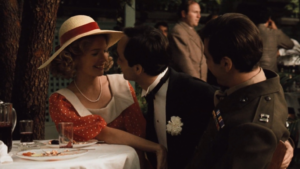 Instead of greeting Michael with care and love—as Tom Hagen does when he first sees Michael, and as an older brother should do after not having seen his younger brother in quite some time—Fredo flicks the back of Michael’s head. While this gesture suggests a kind of playful intimacy, it underscores Fredo’s immaturity and inability to socialize with people in a more dignified way. The blocking of the action in the scene—with Fredo kneeling between Michael and Kay—also conveys his awkwardness and divisiveness. Michael’s act of bringing Kay to the wedding shows his devotion to her and telegraphs that one day, they too might get married. When Fredo sits between them, he separates the two and effectively disrupts the natural state of the couple.
Instead of greeting Michael with care and love—as Tom Hagen does when he first sees Michael, and as an older brother should do after not having seen his younger brother in quite some time—Fredo flicks the back of Michael’s head. While this gesture suggests a kind of playful intimacy, it underscores Fredo’s immaturity and inability to socialize with people in a more dignified way. The blocking of the action in the scene—with Fredo kneeling between Michael and Kay—also conveys his awkwardness and divisiveness. Michael’s act of bringing Kay to the wedding shows his devotion to her and telegraphs that one day, they too might get married. When Fredo sits between them, he separates the two and effectively disrupts the natural state of the couple.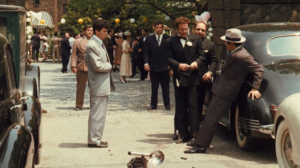 Though Sonny Corleone, the oldest son and therefore the eventual successor to the family business, shares few of Fredo’s character traits, he is also unlike his father in both personality and values. His reckless and impulsive nature is dramatized in his interaction with the FBI agents who are documenting, in an act of surveillance, the people who are attending the wedding. After unsuccessfully attempting to get the agents to leave and being met instead with a stoic face and an FBI ID, Sonny takes his frustration out on one of the agents, yanking his camera away and throwing it on the ground. Afterwards, he’s held back by Peter Clemenza; if Clemenza had not been there, Sonny would have likely thrown some punches. Then, in classic gangster fashion, he drops a couple of crumpled bills on the ground to pay for the broken camera.
Though Sonny Corleone, the oldest son and therefore the eventual successor to the family business, shares few of Fredo’s character traits, he is also unlike his father in both personality and values. His reckless and impulsive nature is dramatized in his interaction with the FBI agents who are documenting, in an act of surveillance, the people who are attending the wedding. After unsuccessfully attempting to get the agents to leave and being met instead with a stoic face and an FBI ID, Sonny takes his frustration out on one of the agents, yanking his camera away and throwing it on the ground. Afterwards, he’s held back by Peter Clemenza; if Clemenza had not been there, Sonny would have likely thrown some punches. Then, in classic gangster fashion, he drops a couple of crumpled bills on the ground to pay for the broken camera. This moment from the wedding scene encapsulates well the cruelty of the irony. His wife is in the foreground, busy talking to other guests and joking about the size of his phallus—which in its own way is a form of endearment. Meanwhile Sonny is almost directly behind her, just having whispered into the bridesmaid’s ear to meet him in a more private setting. He is cheating on his wife literally behind her back, and her close proximity to him while he commits this act suggests how normal this sort of betrayal has become for him. He puts a little care into hiding his unfaithfulness, but his suspicious activities are not unnoticed by his wife, who looks behind her to find him, only to see that he is already gone.
This moment from the wedding scene encapsulates well the cruelty of the irony. His wife is in the foreground, busy talking to other guests and joking about the size of his phallus—which in its own way is a form of endearment. Meanwhile Sonny is almost directly behind her, just having whispered into the bridesmaid’s ear to meet him in a more private setting. He is cheating on his wife literally behind her back, and her close proximity to him while he commits this act suggests how normal this sort of betrayal has become for him. He puts a little care into hiding his unfaithfulness, but his suspicious activities are not unnoticed by his wife, who looks behind her to find him, only to see that he is already gone.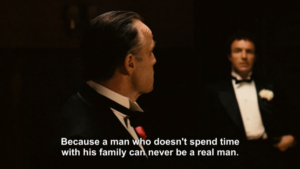 While talking to Johnny Fontane, he asks him if he spends time with his family, which Johnny replies affirmatively to. He follows up with a bit of moral instruction—“Because a man who doesn’t spend time with his family can never be a real man”—and here he looks directly at Sonny, directing the line more to him than to Johnny. Vito doesn’t address the issue in a private one-on-one, but he doesn’t need to, as this line serves as his condemnation of Sonny’s act. And in this condemnation, he embarrasses his son for failing to be a “real man” and a proper Corleone father.
While talking to Johnny Fontane, he asks him if he spends time with his family, which Johnny replies affirmatively to. He follows up with a bit of moral instruction—“Because a man who doesn’t spend time with his family can never be a real man”—and here he looks directly at Sonny, directing the line more to him than to Johnny. Vito doesn’t address the issue in a private one-on-one, but he doesn’t need to, as this line serves as his condemnation of Sonny’s act. And in this condemnation, he embarrasses his son for failing to be a “real man” and a proper Corleone father.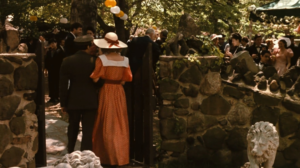 While Michael may not be as immature as his two older brothers, the moment he walks into the wedding a distinction is already made between him and the rest of his family. As he walks into the estate with Kay, noticeably late—13 minutes already into the film to be exact—his military uniform sticks out like a sore thumb. Michael makes deliberate choices to differentiate himself from the rest of the Corleone family, showing up when he wants to instead of at the beginning of the wedding, wearing what he wants to instead of a tuxedo like the rest of his brothers, and bringing a non-Italian-American date (who herself chooses to wear a dress that is Americana in style). These choices construct his character as just another attendee and not a central member of the Corleone family. In his first interaction with a member of the family, Michael hears from Tom that his father is looking for him.
While Michael may not be as immature as his two older brothers, the moment he walks into the wedding a distinction is already made between him and the rest of his family. As he walks into the estate with Kay, noticeably late—13 minutes already into the film to be exact—his military uniform sticks out like a sore thumb. Michael makes deliberate choices to differentiate himself from the rest of the Corleone family, showing up when he wants to instead of at the beginning of the wedding, wearing what he wants to instead of a tuxedo like the rest of his brothers, and bringing a non-Italian-American date (who herself chooses to wear a dress that is Americana in style). These choices construct his character as just another attendee and not a central member of the Corleone family. In his first interaction with a member of the family, Michael hears from Tom that his father is looking for him.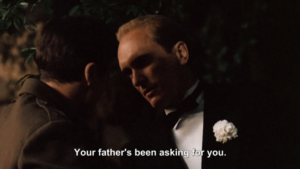 Coppola cuts to a close-up shot here, placing emphasis on both the importance of the statement as well as the secrecy of it—as it is family business—to ensure that Kay will not overhear. But Michael barely reciprocates, simply nodding before sitting back down to continue dining with Kay. This is a direct rejection of Vito, and more generally a rejection of any effort to craft stronger ties with his family and the dubious business they deal in.
Coppola cuts to a close-up shot here, placing emphasis on both the importance of the statement as well as the secrecy of it—as it is family business—to ensure that Kay will not overhear. But Michael barely reciprocates, simply nodding before sitting back down to continue dining with Kay. This is a direct rejection of Vito, and more generally a rejection of any effort to craft stronger ties with his family and the dubious business they deal in.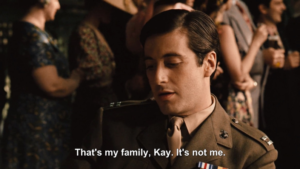 Michael’s decision to create a strong distinction between himself and his family is epitomized in a later scene in which he recounts the story of how Vito helped launch Johnny’s solo career. As he relates Vito’s criminal activities to Kay in vivid detail, he ends with the line “That’s my family Kay. It’s not me.” Michael makes it clear to Kay that he no longer feels a sense of belonging within his own family. It appears that Michael, decked out in his military uniform, is attempting to rebrand himself as a law-abiding, patriotic citizen — the exact opposite of a Corleone.
Michael’s decision to create a strong distinction between himself and his family is epitomized in a later scene in which he recounts the story of how Vito helped launch Johnny’s solo career. As he relates Vito’s criminal activities to Kay in vivid detail, he ends with the line “That’s my family Kay. It’s not me.” Michael makes it clear to Kay that he no longer feels a sense of belonging within his own family. It appears that Michael, decked out in his military uniform, is attempting to rebrand himself as a law-abiding, patriotic citizen — the exact opposite of a Corleone.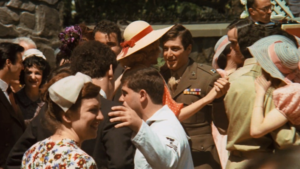 Furthermore, we can see that, outside of his decisions to distance himself from the family, Michael is still a bearer of Sicilian values and culture: he talks about Sicilian family titles, recounts stories regarding his father, and even waltzes with his significant other, much like Vito is seen doing at various points in the wedding.
Furthermore, we can see that, outside of his decisions to distance himself from the family, Michael is still a bearer of Sicilian values and culture: he talks about Sicilian family titles, recounts stories regarding his father, and even waltzes with his significant other, much like Vito is seen doing at various points in the wedding.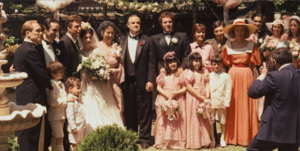
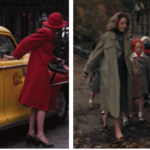
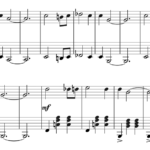

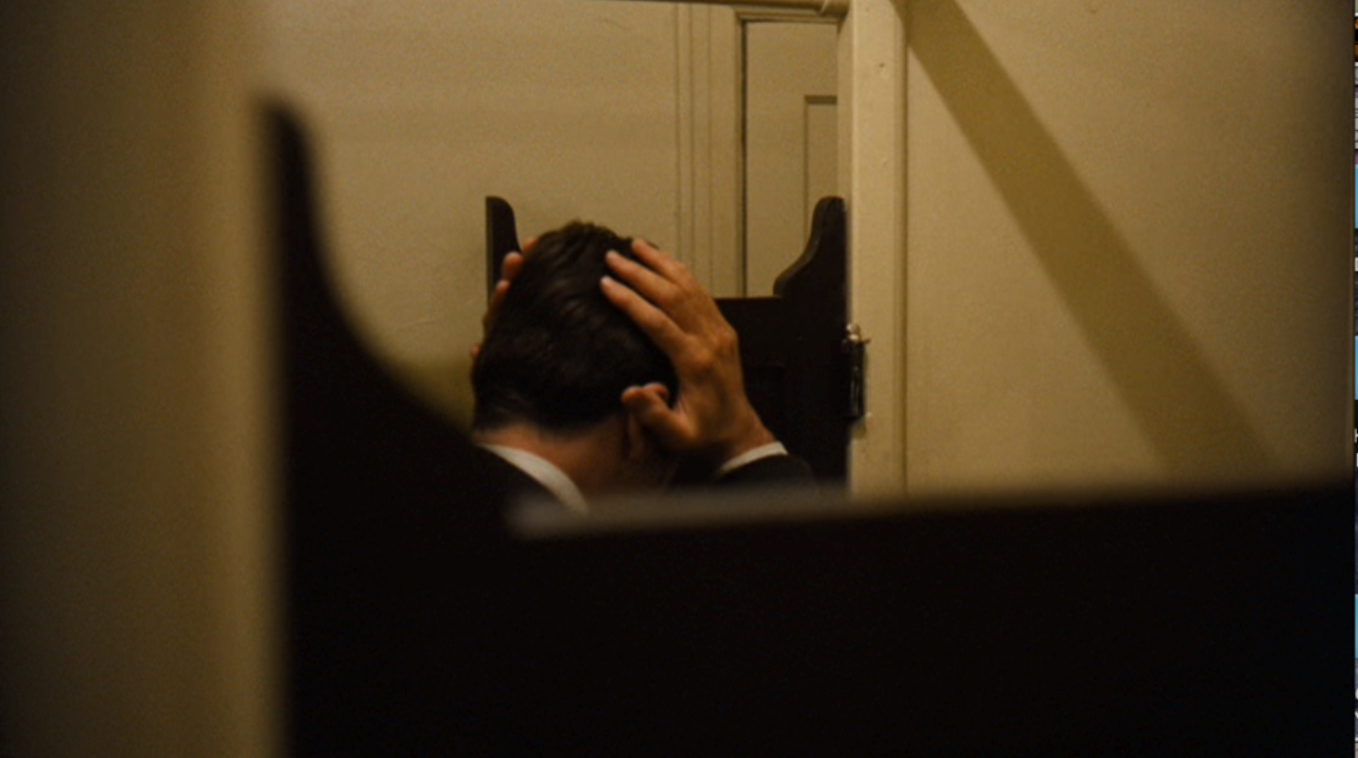

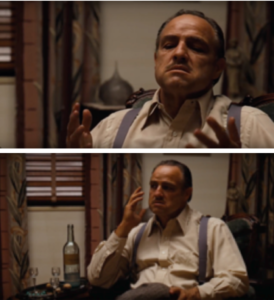 As the head of the Family, Vito is not stripped of his patriarchal position when he sits down. Rather, his status is elevated: he is a king upon his throne. With all eyes drawn toward him, he is careful to use limited and deliberate physical gestures to conceal his thoughts and emotions. When Tom Hagen briefs Vito about Sollozzo’s request to receive protection in exchange for a percentage of the profits of his drug trade, Vito sits with his legs crossed while reclining in his seat. Before the meeting with Sollozzo commences, Vito nods his head, shrugs his shoulders, and sways—as if he were doing Sollozzo a favor by indulging his offer, only bestowing the minimum physical attention required to hear his request. He also asks Tom if he is “not too tired,” as if to suggest his own fatigue as the Don. His body language reveals a disinclination towards stretching the reach of the Family business, as it jeopardizes the familial affiliations that he has established within and outside his blood ties. When Sonny asks him what his decision is going to be, Vito raises his hand from his cheek before resting it on his chin, withholding his thoughts until the next scene.
As the head of the Family, Vito is not stripped of his patriarchal position when he sits down. Rather, his status is elevated: he is a king upon his throne. With all eyes drawn toward him, he is careful to use limited and deliberate physical gestures to conceal his thoughts and emotions. When Tom Hagen briefs Vito about Sollozzo’s request to receive protection in exchange for a percentage of the profits of his drug trade, Vito sits with his legs crossed while reclining in his seat. Before the meeting with Sollozzo commences, Vito nods his head, shrugs his shoulders, and sways—as if he were doing Sollozzo a favor by indulging his offer, only bestowing the minimum physical attention required to hear his request. He also asks Tom if he is “not too tired,” as if to suggest his own fatigue as the Don. His body language reveals a disinclination towards stretching the reach of the Family business, as it jeopardizes the familial affiliations that he has established within and outside his blood ties. When Sonny asks him what his decision is going to be, Vito raises his hand from his cheek before resting it on his chin, withholding his thoughts until the next scene.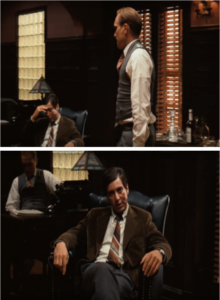 After he inherits Vito’s throne, Michael’s sitting posture recalls his father’s — but with some striking differences. When Michael offers a plan to exact retribution for his father’s shooting, he positions himself in an armchair in a similar manner to his father, crossing his legs and lolling in the furniture. However, Michael is not as calm and collected as Vito had been: he rubs his eyebrows and slumps in his chair, moving his body back and forth before proceeding with his plan. He’s restless—sweaty and squirming. He wants to take immediate action, but he does not act upon his impulses. In the following moments, he places both arms on the handles of the chair as a way to ground himself within the turbulence. As the camera zooms in, Michael’s body becomes more relaxed while still tilting forward: we sense that he is more comfortable with his position, prepared to prove his power. He slurs his words, recalling how his father often mumbles his words, but he does so in anger, his gestures intensified by the sternness of his stare and speech.
After he inherits Vito’s throne, Michael’s sitting posture recalls his father’s — but with some striking differences. When Michael offers a plan to exact retribution for his father’s shooting, he positions himself in an armchair in a similar manner to his father, crossing his legs and lolling in the furniture. However, Michael is not as calm and collected as Vito had been: he rubs his eyebrows and slumps in his chair, moving his body back and forth before proceeding with his plan. He’s restless—sweaty and squirming. He wants to take immediate action, but he does not act upon his impulses. In the following moments, he places both arms on the handles of the chair as a way to ground himself within the turbulence. As the camera zooms in, Michael’s body becomes more relaxed while still tilting forward: we sense that he is more comfortable with his position, prepared to prove his power. He slurs his words, recalling how his father often mumbles his words, but he does so in anger, his gestures intensified by the sternness of his stare and speech.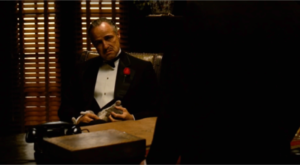 Vito and Michael both use hand movements that reveal them suppressing their anger and frustration. In the opening scene, mortician Amerigo Bonasera offers to pay Vito Corleone in exchange for revenge upon the men who abused his daughter—an offer which offends the Don, as it insinuates he is both a killer and can be “bought.” Prior to this exact moment, Vito’s hand is petting and playing with a cat sitting on his lap; just after, his grip tightens around the animal’s head. The sequence of gestures suggests a few meanings: (1) he is crushing his urge to act upon his anger towards Amerigo Bonasera—he is a man, “not a murderer”—which would demonstrate a childish weakness that cannot be associated with the patriarch of a family, let alone the Family; and (2) given that the image of a cat often carries both feminine and sexual connotations, Vito’s intensifying hold shows him flexing his masculine power and exerting his dominance, his full control.
Vito and Michael both use hand movements that reveal them suppressing their anger and frustration. In the opening scene, mortician Amerigo Bonasera offers to pay Vito Corleone in exchange for revenge upon the men who abused his daughter—an offer which offends the Don, as it insinuates he is both a killer and can be “bought.” Prior to this exact moment, Vito’s hand is petting and playing with a cat sitting on his lap; just after, his grip tightens around the animal’s head. The sequence of gestures suggests a few meanings: (1) he is crushing his urge to act upon his anger towards Amerigo Bonasera—he is a man, “not a murderer”—which would demonstrate a childish weakness that cannot be associated with the patriarch of a family, let alone the Family; and (2) given that the image of a cat often carries both feminine and sexual connotations, Vito’s intensifying hold shows him flexing his masculine power and exerting his dominance, his full control.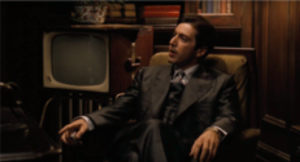 Michael, on the other hand, is less composed and constrained in his physical mannerisms—his body is seemingly riddled with anxiety. After Michael’s return from Sicily, he makes significant decisions as the new “head of the Family,” including relocating the business transactions to Las Vegas and replacing Tom Hagen as consigliere. During this scene, Michael is twiddling a zippo lighter between his fingers, smoking a cigarette, and prolongedly pressing it into an ashtray.
Michael, on the other hand, is less composed and constrained in his physical mannerisms—his body is seemingly riddled with anxiety. After Michael’s return from Sicily, he makes significant decisions as the new “head of the Family,” including relocating the business transactions to Las Vegas and replacing Tom Hagen as consigliere. During this scene, Michael is twiddling a zippo lighter between his fingers, smoking a cigarette, and prolongedly pressing it into an ashtray.
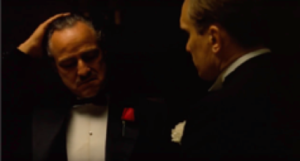 After the opening scene, Don Vito runs a hand against his grey, slicked-backed hair and qualifies his terms for the mortician’s debt: “We’re not murderers, despite what this undertaker says.” In this scene, Vito is literally scratching his head at his decision to expand the scope of the Family to meet the pleas of an acquaintance who has deliberately avoided them. Yet Vito’s grooming habit is second nature to him—he stays in character as the cool and collected Don.
After the opening scene, Don Vito runs a hand against his grey, slicked-backed hair and qualifies his terms for the mortician’s debt: “We’re not murderers, despite what this undertaker says.” In this scene, Vito is literally scratching his head at his decision to expand the scope of the Family to meet the pleas of an acquaintance who has deliberately avoided them. Yet Vito’s grooming habit is second nature to him—he stays in character as the cool and collected Don.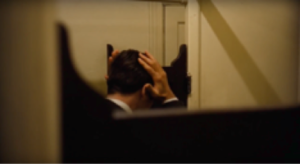 This gesture is replayed in a different key in the pivotal scene at the Italian restaurant, in which Michael struggles to carry out the plot he proposed—to kill Sollozzo and his police guard. Just after he retrieves the gun from the restaurant’s toilet, Michael stands in front of the bathroom’s mirror and presses both hands against his hair in an attempt to gather himself. Here, Michael is on the edge of becoming a part of the family — a family that he had pointedly described, to his girlfriend Kay, as “not me”. His fingers are pushed against his head—he is trying to wrap his brain around his decision. By executing his plan, he not only will be initiated into the business, but also will finally be able to feel like a part of the Corleone family by embodying the role of his father. With the gun concealed in his jacket, Michael seats himself at the table with Sollozzo and his police guard; he brushes his hair back and switches from speaking in Italian to English when staking his claim: “What’s most important to me is that I have a guarantee: no more attempts on my father’s life.” By protecting the patriarch, Michael secures his succession.
This gesture is replayed in a different key in the pivotal scene at the Italian restaurant, in which Michael struggles to carry out the plot he proposed—to kill Sollozzo and his police guard. Just after he retrieves the gun from the restaurant’s toilet, Michael stands in front of the bathroom’s mirror and presses both hands against his hair in an attempt to gather himself. Here, Michael is on the edge of becoming a part of the family — a family that he had pointedly described, to his girlfriend Kay, as “not me”. His fingers are pushed against his head—he is trying to wrap his brain around his decision. By executing his plan, he not only will be initiated into the business, but also will finally be able to feel like a part of the Corleone family by embodying the role of his father. With the gun concealed in his jacket, Michael seats himself at the table with Sollozzo and his police guard; he brushes his hair back and switches from speaking in Italian to English when staking his claim: “What’s most important to me is that I have a guarantee: no more attempts on my father’s life.” By protecting the patriarch, Michael secures his succession.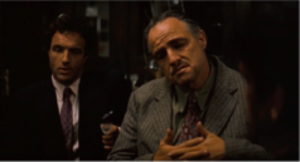 When Vito meets with Sollozzo to listen to his proposition (only to decline), his blazer is unbuttoned, and he droops one arm over the chair while the other dangles from his hip. Vito gives the appearance of approachability while still upholding his authority—he does not need to exercise his dominance in the situation because his mere presence is enough. Vito’s amiability is not so much a sign of respect for Sollozzo, but a means of maintaining respectability as a representative of the Corleone tribe. As Vito turns down Sollozzo’s request, his hands are clasped, but not fastened together, and he strokes and shrugs his thumbs: “It doesn’t make any difference to me what a man does for a living.” Vito is not interested in what can be done to advance his enterprise, but in what he can do to preserve the relationships with his current business partners.
When Vito meets with Sollozzo to listen to his proposition (only to decline), his blazer is unbuttoned, and he droops one arm over the chair while the other dangles from his hip. Vito gives the appearance of approachability while still upholding his authority—he does not need to exercise his dominance in the situation because his mere presence is enough. Vito’s amiability is not so much a sign of respect for Sollozzo, but a means of maintaining respectability as a representative of the Corleone tribe. As Vito turns down Sollozzo’s request, his hands are clasped, but not fastened together, and he strokes and shrugs his thumbs: “It doesn’t make any difference to me what a man does for a living.” Vito is not interested in what can be done to advance his enterprise, but in what he can do to preserve the relationships with his current business partners.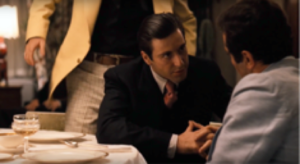 Michael is not as gentle, however, when he arrives in Las Vegas to buy Moe Greene’s casino and offer Johnny Fontaine a new contract. In this scene, Michael clasps his hands as well, except with his thumbs pressed together. Not only is he steadfast in his position, but also he’s confident that no one in the room can “refuse” him nor the strength he flexes. Moe Greene then barges in and argues with Michael over the notion that he can “buy [him] out,” and Fredo defends Moe and questions Michael’s reasoning. Echoing the earlier scene in which his father advised Sonny to “never tell anyone outside the family what [he thinks] again,” Michael warns Fredo never to “take sides with anyone against the family again.”
Michael is not as gentle, however, when he arrives in Las Vegas to buy Moe Greene’s casino and offer Johnny Fontaine a new contract. In this scene, Michael clasps his hands as well, except with his thumbs pressed together. Not only is he steadfast in his position, but also he’s confident that no one in the room can “refuse” him nor the strength he flexes. Moe Greene then barges in and argues with Michael over the notion that he can “buy [him] out,” and Fredo defends Moe and questions Michael’s reasoning. Echoing the earlier scene in which his father advised Sonny to “never tell anyone outside the family what [he thinks] again,” Michael warns Fredo never to “take sides with anyone against the family again.”
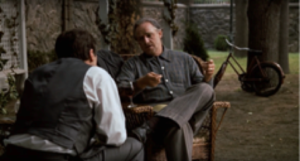 In their final interaction in the film, Michael is already Don of the Family and Vito is “retired.” The viewer can sense a shift in Vito’s demeanor; he is smiling, joking, drinking wine, and sitting with his right leg folded above the other. He is not hunched over, as he had been in many previous scenes. The burden of the Family business has been removed from his shoulders, and he can take it easy, if only for an instant.
In their final interaction in the film, Michael is already Don of the Family and Vito is “retired.” The viewer can sense a shift in Vito’s demeanor; he is smiling, joking, drinking wine, and sitting with his right leg folded above the other. He is not hunched over, as he had been in many previous scenes. The burden of the Family business has been removed from his shoulders, and he can take it easy, if only for an instant.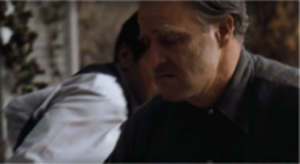 Tellingly, when Vito positions himself in his seat, he obscures the image of Michael. The camera work suggests how succession works in this family: the importance of the patriarch means that there’s no room for others, just the single male head. To be powerful, to be head of the family: this aspiration is tied to Michael becoming singular, with a way of moving his body that—however indebted to his father—is his and his alone.
Tellingly, when Vito positions himself in his seat, he obscures the image of Michael. The camera work suggests how succession works in this family: the importance of the patriarch means that there’s no room for others, just the single male head. To be powerful, to be head of the family: this aspiration is tied to Michael becoming singular, with a way of moving his body that—however indebted to his father—is his and his alone.